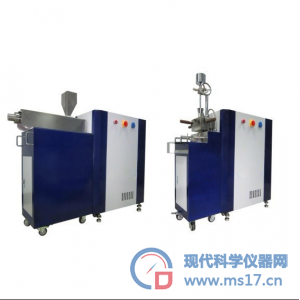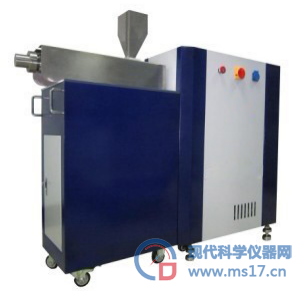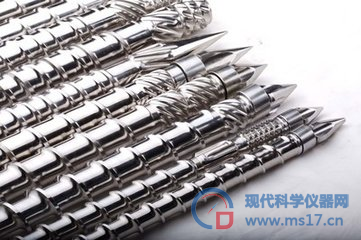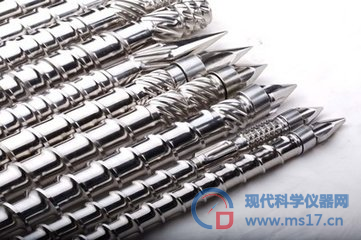


地址:北京市海淀区上地十街1号
电话:15132636097
聚合物材料转矩流变仪 转矩流变仪是研究聚合物材料的流动与变形、塑化、热剪切稳定性、动态流变性能和塑化行为并将结果用扭矩--时间和扭矩--温度等用图表形式表示出来的理想设备。
本机整体美观,主体钣金采用乳白色与蓝色的配色方案,也可以根据用户的要求颜色处理。不锈钢部分采用SUS304不锈钢。
计算机软件具可数据采集、存储、计算、分析和输出功能,可根据用户要求打印试验报告。
可广泛地应用于科研和生产,是进行科学研究以及指导生产的重要仪器。与研究材料流动性的一般性仪器——粘度计相比,该流变仪提供了更接近于实际加工的动态测量方法,可以在类似实际加工的情况下,连续、准确可靠地对材料的流变性能进行测定,如多组份物料的混合、热固性树脂的交联固化、弹性体的硫化,材料的动态稳定性以及螺杆转速对体系加工性能的影响等。
聚合物材料转矩流变仪 应用领域
1、UPVC加工性能研究及材料开发
2、热塑性材料的开发及加工性能研究
3、交联、热固性树脂固化性能研究
4、教学科研应用
1. 电机功率:3.0kw伺服电机
2. 电机转速:3000 rpm
3. 电机驱动器3.0 kw
4. 减速器:1:20
5. 动力输出转速:0 ~ 150rpm
6. 转速控制精度:0 .05%F.S
7. 温度控制:5路测温,其中4路控温
8. 静态测量精度:0.1°C
9. 温度控制精度:±1°C
10. 转矩测量量程:0 ~ 250Nm
11. 转矩测量精度:0.1%F.S
12. 熔体压力测量量程:0.1 ~ 100 Mpa
13. 熔体压力测量精度:0.5%F.S
14. 软件:、测控软件、聚合物熔体粘度测量数据处理软件、挤出机数据处理软件、混合器数据处理软件。
15. 图形显示:转速、转矩、温度、压力
16. 电压:AC380V 7.5kw
双螺杆挤出机组主要应用于橡塑和工程树脂的填充、共混、改性、增强、氯化聚丙稀和高吸水性树脂的脱挥处理;可降解母粒、聚酰胺缩聚、聚氨酯加聚反应的挤出,碳粉、磁粉的造粒、电缆用绝缘料、护套料、低烟低卤阻燃型PVC电缆料及各种硅烷交联料的制备等。
可以用来研究热塑性材料的热稳定性、剪切稳定性、流动和塑化行为,其最大特点是能在类似实际加工过程中连续准确可靠地对体系的流变性能进行测定,还可以完成热固性材料的固化特性测试。
本设备配有不同参数的螺杆,在具有一定温度的圆筒内旋转,筒的另端设有送料斗。当原料被送至筒的2/3处时逐步增塑,进入到筒的剩余部分内被均化,当所有颗粒全部溶化后即可利用毛细管挤出模具成为母料或注入模具成形,同时设备也完成对材料的表现粘度与剪切速度及剪切应力关系的测量。
挤出机可以根据不同的物料特性选择不同类型的螺杆,螺杆的压缩比不同,对物料的试验性能有很大的影响。螺杆可以方便的互换,以支持对不同物料的快速试验。
橡塑材料在加工成型的过程中,几乎都要涉及其流动性。例如,在挤出、注模、吹膜、压延等工艺中,材料的流动行为都是十分重要的。材料的流动性不但影响加工行为,还会影响最终产品的力学性能。例如,分子取向对模塑产品,薄膜和纤维的力学性能都有很大影响。而分子取向的类型和程度主要是由加工过程中流动场的特点和材料的流动行为所决定。
挤出式毛细管流变仪主要由进口伺服电机、减速器、挤出螺杆、口模、测控模块、温度模块、压力传感器、电子计算机及测控软件组成。其原理是经由螺杆的旋转,带动物料经由口模挤出,在这个过程中测量材料的剪切速率和剪切压力,计算机物料在规定温度下的粘度。同时,挤出式毛细管流变仪也可以做为生产工艺测验的仪器,通过更换不同类型的口模,以少量物料进行实际的生产加工,在这个过程中通过控制挤出速度、熔体温度、配方比例等多种手段,对生产工艺进行验证。
A torque rheometer is an ideal device for studying the flow and deformation, plasticization, thermal shear stability, dynamic rheological properties, and plasticization behavior of polymer materials, and presenting the results in graphical forms such as torque time and torque temperature.
The overall appearance of this machine is beautiful, and the main sheet metal adopts a color scheme of milky white and blue, which can also be processed according to the user's requirements. The stainless steel part adopts SUS304 stainless steel.
Computer software has functions for data collection, storage, calculation, analysis, and output, and can print test reports according to user requirements.
It can be widely used in scientific research and production, and is an important instrument for conducting scientific research and guiding production. Compared with the general instrument for studying material flowability - viscometer, this rheometer provides a dynamic measurement method that is closer to actual processing. It can continuously, accurately and reliably measure the rheological properties of materials in situations similar to actual processing, such as the mixing of multi-component materials, crosslinking and curing of thermosetting resins, vulcanization of elastomers, dynamic stability of materials, and the influence of screw speed on system processing performance.
application area
1. Research on Processing Performance and Material Development of UPVC
2. Development and Processing Performance Research of Thermoplastic Materials
3. Research on the Curing Performance of Crosslinked and Thermosetting Resins
4. Teaching and research applications
Main technical features and configurations
1. Motor power: 3.0kw servo motor
2. Motor speed: 3000 rpm
3. Motor driver 3.0 kW
4. Reducer: 1:20
5. Power output speed: 0~150rpm
6. Speed control accuracy: 0.05% F.S
7. Temperature control: 5 temperature measurement channels, including 4 temperature control channels
8. Static measurement accuracy: 0.1 ° C
9. Temperature control accuracy: ± 1 ° C
10. Torque measurement range: 0~250Nm
11. Torque measurement accuracy: 0.1% F.S
12. Melt pressure measurement range: 0.1~100 Mpa
13. Melt pressure measurement accuracy: 0.5% F.S
14. Software: Measurement and control software, polymer melt viscosity measurement data processing software, extruder data processing software, mixer data processing software.
15. Graphic display: speed, torque, temperature, pressure
16. Voltage: AC380V 7.5kw
The twin-screw extruder unit is mainly used for filling, blending, modifying, strengthening rubber and engineering resins, as well as devolatilization treatment of chlorinated polypropylene and high water absorbent resins; The extrusion of biodegradable masterbatch, polyamide condensation polymerization, polyurethane addition polymerization reaction, granulation of carbon powder and magnetic powder, preparation of insulation materials for cables, sheath materials, low smoke and low halogen flame retardant PVC cable materials, and various silane crosslinking materials.
It can be used to study the thermal stability, shear stability, flow and plasticization behavior of thermoplastic materials. Its biggest feature is that it can continuously, accurately and reliably measure the rheological properties of the system in similar actual processing processes, and can also complete the curing characteristic testing of thermosetting materials.
This device is equipped with screws with different parameters, which rotate inside a cylinder with a certain temperature, and there is a feeding hopper at the other end of the cylinder. When the raw materials are sent to 2/3 of the barrel, they gradually plasticize and enter the remaining part of the barrel for homogenization. After all particles dissolve, they can be extruded into the master material using capillary tubes or injected into the mold for forming. At the same time, the equipment also completes the measurement of the relationship between the apparent viscosity of the material, shear rate, and shear stress.
The extruder can select different types of screws based on the characteristics of different materials, and the compression ratio of the screws varies, which has a significant impact on the experimental performance of the materials. The screws can be easily interchanged to support rapid testing of different materials.
In the process of processing and forming rubber and plastic materials, their fluidity is almost always involved. For example, in processes such as extrusion, injection molding, blow molding, and rolling, the flow behavior of materials is very important. The fluidity of materials not only affects processing behavior, but also affects the mechanical properties of the final product. For example, molecular orientation has a significant impact on the mechanical properties of molded products, films, and fibers. The type and degree of molecular orientation are mainly determined by the characteristics of the flow field during the processing and the flow behavior of the material.
The extrusion capillary rheometer mainly consists of an imported servo motor, reducer, extrusion screw, die, measurement and control module, temperature module, pressure sensor, electronic computer, and measurement and control software. The principle is to rotate the screw and extrude the animal material through the mouth mold. During this process, the shear rate and shear pressure of the material are measured, and the viscosity of the material at the specified temperature is calculated. At the same time, the extrusion capillary rheometer can also be used as an instrument for production process testing. By replacing different types of molds and using a small amount of material for actual production processing, various methods such as controlling extrusion speed, melt temperature, and formula ratio are used to verify the production process.北广精仪公司电性能及橡胶塑料相关产品:
BEST-19导体材料电阻率测试仪
BQYH-96塑料球压痕硬度计
BWN拉力材料试验机(电子拉力,金属材料,非金属材料,管材,高低温,液压伺服拉力试验机)
BDJC-10KV-200KV电压击穿试验仪(介,固体绝缘材料电气介电强度试验机)
BEST-121体积表面电阻率测定仪(可测试固体液体膏体粉末材料)
M-200橡胶塑料滑动摩擦试验机(国标,非国标,可定制)
GDAT-A介电常数介质损耗测试仪(可测试固体液体)
BQS-37A高频介电常数介质损耗测试仪
BMD-A计算机控制马丁耐
BDH-20KV绝缘材料耐电弧性能试验仪/高电压小电流测试仪
BWK-300A液显热变形维卡软化点温度测定仪
HMMD-A海绵密度测定仪
BRT-400Z熔体流动速率测定仪/熔融指数仪
JF-3氧指数测定仪
HMYX-2000海绵泡沫压陷硬度测定仪
HMLS-1000海绵拉伸强度试验机
HMLQ-500海绵泡沫落球回弹仪
BLD-6000V高压漏电起痕试验仪
HMPL-2000海绵泡沫疲劳冲击测定仪
BLD-600V漏电起痕试验仪
HMYS-200海绵压缩永久变形试验机
BLB-30管材落镖冲击试验机
HMQG-100海绵泡沫切割机
BCM-03摆锤薄膜冲击试验机
XCY-III低温脆性试验机
BZR-A汽车内饰材料阻燃性能试验机
CZF-5水平垂直燃烧试验仪
BLC-2000落球冲击试验机
